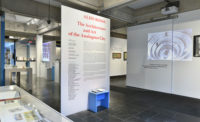Review of 'The Museum Is Not Enough'
By Canadian Centre for Architecture

The Museum Is Not Enough, by Canadian Centre for Architecture. CCA/Sternberg Press, distributed by MIT Press, 200 pages, $22.95.
Why would an institution that collects, curates, and exhibits architecture produce a book called The Museum Is Not Enough? Not enough for what? Not enough to educate? To entertain? To change the world?
Architecture museums and departments have always been compromised by their inability to exhibit their actual subject. Art museums show art, film museums show films, but architecture museums show mostly drawings and models of actual architecture. Debates over style or aesthetics can be illustrated by representations and are important to cultural discourse, but the new questions being imposed on architecture today—particularly social, technological, and environmental—are not easily shown in a museum context. So what is the architecture museum’s role?
The Museum Is Not Enough takes up this question. It is written in the first person singular, yet it is not by an individual but by a five-person collective—which includes Mirko Zardini, director of the CCA from 2005 to 2019, and Giovanna Borasi, a CCA curator who assumed the title of director last month—posing as the voice of the Canadian Centre for Architecture. If the first-person voice is atypical for an institution, so is the introspective narrative, which is organized along “nine lines of thinking” that include phrases such as “I seek,” “I’m wary,” and “I could reinvent.” This “personification” of the institution suggests new ways of thinking of the museum as an actor rather than a place for archives and exhibitions. But the CCA has always surpassed the usual expectations of museums. Its 20th-century archives are open to visiting scholars and accessible for reference online, the CCA has enlisted numerous guest curators to stage exhibitions and events, and founding director Phyllis Lambert commissioned architectural photographs for the collection. So why is this not enough?
Some answers may lie in the commissioned conversations interspersed with the lines of thinking. These include Mark Wigley (professor of architecture at Columbia University) and Kieran Long (a British architecture critic and curator), who discuss the relationship of archival research to our changing world. Additionally, 12 international curators and writers each select three recent architecture exhibitions that they think will be “relevant” for the discipline in the future. (Their choices include the Prada Foundation’s 2018 Machines à penser in Venice and architect Sou Fujimoto’s Architecture Is Everywhere installation at the 2015 Chicago Architecture Biennial.)
Is the need for relevance the reason for this introspective book? What does relevance mean in a post-truth world that is returning to nationalist politics and facing global climate change? When technology and science seem to hold the keys to the future, what is the role of museums that exhibit work associated with the arts?
In an interview with activist and Adbusters editor Kalle Lasn, the CCA asks how institutions can address the urgent problems of today. Lasn replies that institutions “have to be full of fear about the future [and] realize we’re in a crisis—of finance, of climate, of democracy—that the current global system is incapable of solving. If you want to be relevant, you have to get scared. And then you have to get angry.”
Fear and anger are not easily conveyed in a museum, but they are motivations for change. Arguably, both the architecture museum and architecture are at critical points of transition, if not transformation. Sustainability practices, for example, are important, but they are neither easy to exhibit nor sufficient to overcome the climate crisis. Instead, as The Museum Is Not Enough clearly suggests, new thinking and new actions are required on all fronts.



